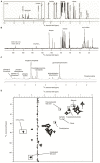NMR-Based Milk Metabolomics
- PMID: 24957988
- PMCID: PMC3901264
- DOI: 10.3390/metabo3020204
NMR-Based Milk Metabolomics
Abstract
Milk is a key component in infant nutrition worldwide and, in the Western parts of the world, also in adult nutrition. Milk of bovine origin is both consumed fresh and processed into a variety of dairy products including cheese, fermented milk products, and infant formula. The nutritional quality and processing capabilities of bovine milk is closely associated to milk composition. Metabolomics is ideal in the study of the low-molecular-weight compounds in milk, and this review focuses on the recent nuclear magnetic resonance (NMR)-based metabolomics trends in milk research, including applications linking the milk metabolite profiling with nutritional aspects, and applications which aim to link the milk metabolite profile to various technological qualities of milk. The metabolite profiling studies encompass the identification of novel metabolites, which potentially can be used as biomarkers or as bioactive compounds. Furthermore, metabolomics applications elucidating how the differential regulated genes affects milk composition are also reported. This review will highlight the recent advances in NMR-based metabolomics on milk, as well as give a brief summary of when NMR spectroscopy can be useful for gaining a better understanding of how milk composition is linked to nutritional or quality traits.
Figures
References
-
- Elgersma A., Tamminga S., Ellen G. Modifying milk composition through forage. Anim. Feed Sci. Tech. 2006;131:207–225. doi: 10.1016/j.anifeedsci.2006.06.012. - DOI
-
- Auldist M.J., Hubble I.B. Effects of mastitis on raw milk and dairy products. Aust. J. Dairy Technol. 1998;53:28–36.
LinkOut - more resources
Full Text Sources
Other Literature Sources


